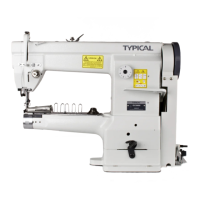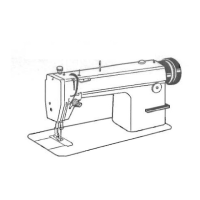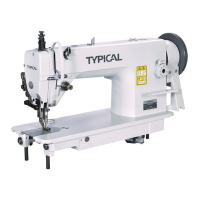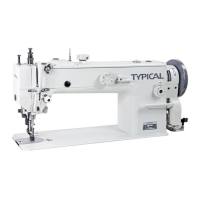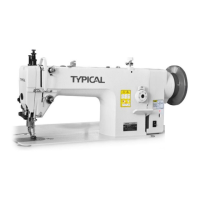9
25
28
26
27
a.If the stiich form is the same as shown in Fig.24b, it
indicates that the needle thread is too tight or the bobbin
thread is too loose. Turn the thread tension screw counter
clockwise to release the needle thread tension, or turn the
adjusting screw with a screwdriver to increase the bobbin
thread tension (Fig.25.26).
b.If the needle thread is too loose and the bobbin thread
is too tight as shown in Fig,24c, turn the thread tension
screw clockwise to increase the needle thread tension,
or loosen the bobbin lace screw to reduce the bobbin
thread tension.(Fig.25,26).
For special sewing with special thread, the required
tension can be obtained by adjusting the strength and
stroke of the thread take-up spring.
5.2 Adjusting the pressure of the presser foot (Fig.27)
The pressure of the presser foot should be adjusted
according to the thickness of the sewing materials. If
stitch on heavy duty materials, the pressure should be
increased by turning the pressure adjusting screw on
the back of the arm clockwise. To reduce the pressure,
turn it counter-clockwise.
5.3 Safety clutch device
The safety clutch device is to prevent the hook and
teeth-belt from destroy when the needle thread is drawn
into the hook for abnormal load during the operation.
5.3.1 Function of the safety clutch device (Fig.28)
a. When the safety clutch device is working, the
teeth-belt will remove the load. The rock shaft stops
rotating., only the upper shaft rotates, then the machine
stops work.
b. Clean off the needle thread which is drawn in the hook.
c. Turn the shaft of the teeth-belt with hand to check if
the rock shaft can turn smoothly, then reset the safety
clutch device.
Needle thread tension adjusting screw
Loosen
Tighten
Strengthen
Weaken
Pressure adjusting screw
Safety clutch
Pulley
Belt shaft
Stop plate
Strengthen
Weaken
Needle thread tension

